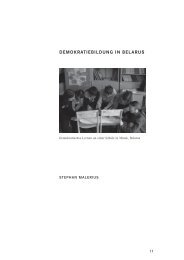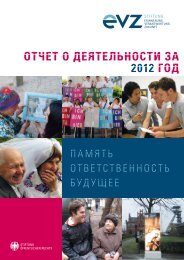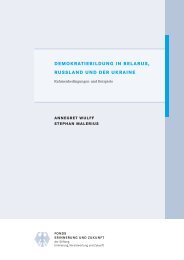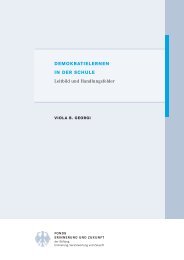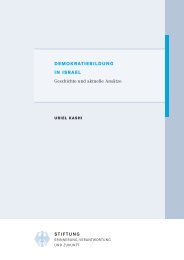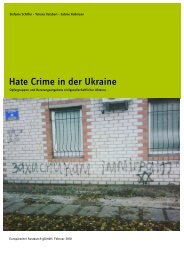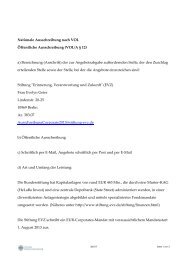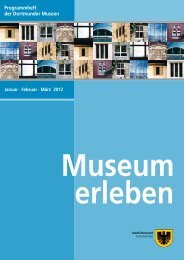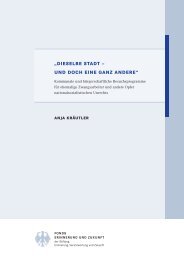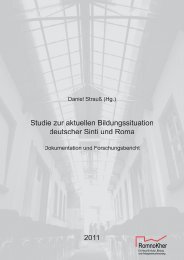chapter 2 - Stiftung "Erinnerung, Verantwortung und Zukunft"
chapter 2 - Stiftung "Erinnerung, Verantwortung und Zukunft"
chapter 2 - Stiftung "Erinnerung, Verantwortung und Zukunft"
You also want an ePaper? Increase the reach of your titles
YUMPU automatically turns print PDFs into web optimized ePapers that Google loves.
Patrice G. Poutrus<br />
to asylum was highly contested from its inception. 19 The Federal Administrative Court’s 1975 ruling confirmed<br />
that the constitution took precedence over lesser regulations such as the Police Decree on Foreigners and the<br />
1965 Aliens Act, as well as political considerations, and especially policies on foreigners. Because the liberal<br />
right to asylum clashed with West Germany’s restrictive immigration policies, the ruling did not bring an end<br />
to the debate on political asylum in West Germany. 20 Nonetheless, the Federal Administrative Court’s 1975<br />
ruling was a significant break with prevailing refugee and asylum policies. As such, the ruling was not simply<br />
the outcome of a process of legal transformation, but also an expression of the transformations in political<br />
attitudes towards foreign refugees and asylum seekers since the 1950s. 21<br />
The Hungarian Refugees and Asylum Policies<br />
After the Asylum Ordinance of 1953, the revolutionary uprising in Hungary and the wave of refugees that<br />
followed its suppression by Soviet troops in the fall and winter of 1956 marked a new turning point. West German<br />
asylum policy increasingly moved from a straightforward rejection of foreign refugees to a pragmatism<br />
that was inflected by the vicissitudes of the Cold War. 22 Hungarian refugees were met with great sympathy in<br />
neighboring European countries, including the Federal Republic of Germany. News coverage and pictures of<br />
the Soviet military intervention in Hungary, a former German ally, raised awareness among the West German<br />
population and led to public displays of solidarity that reflected longstanding anxieties about the Soviet Union<br />
and a sense of belonging to the “democratic West.” 23 Within the context of an ever-worsening confrontation<br />
between the Eastern and Western blocs in Europe, the West German public and parliament regarded the<br />
Hungarian refugees as allies in the fight against Communism. 24<br />
At the same time, West German federal ministries initially reacted to Austria’s request for help in absorbing<br />
Hungarian refugees with considerable caution. The Interior Ministry in particular took pains to maintain its<br />
defensive stance in accepting foreign refugees. As it had in 1952, the Interior Ministry pointed to the burden of<br />
postwar expellees and ongoing internal immigration from the GDR. However, the steady flow of refugees from<br />
Hungary and the dramatically deteriorating humanitarian situation in Austrian refugee camps soon <strong>und</strong>ermined<br />
the West German position. 25 The cautious attitude toward Hungarian refugees also encountered little<br />
<strong>und</strong>erstanding in the emotionally charged political atmosphere of West German society at the time. In late<br />
November 1956, the federal government decided to admit over 10,000 Hungarian refugees. 26 As a result, local<br />
immigration police authorities could no longer reject individual asylum appeals by Hungarian refugees, even<br />
in the case of refugees who had entered West Germany from the safe refuge of Austria. The legal basis for this<br />
new policy was justified with the argument that the Hungarian revolution was the result of the Communist<br />
power grab of 1948 and 1949 – in other words, before the deadline of January 1, 1951. As a result, the Hungarian<br />
19 See Simone Wolken, Das Gr<strong>und</strong>recht auf Asyl als Gegenstand der Innen- <strong>und</strong> Rechtspolitik in der B<strong>und</strong>esrepublik Deutschland (Frankfurt a.M., 1988): 37; and<br />
Simone Klausmeier, Vom Asylbewerber zum “Scheinasylant”: Asylrecht <strong>und</strong> Asylpolitik in der B<strong>und</strong>esrepublik Deutschland seit 1973 (Berlin, 1984): 3-16.<br />
20 Klaus J. Bade, Normalfall Migration: Deutschland im 20. <strong>und</strong> frühen 21. Jahrh<strong>und</strong>ert (Bonn, 2004).<br />
21 Peter Nicolaus, “Der Flüchtlingsbegriff in der obergerichtlichen Rechtsprechung,” in Asylrecht <strong>und</strong> Asylpolitik – eine Bilanz des letzten Jahrzehnts, ed.<br />
Gustav-Stresemann-Institut e.V. (Bonn, 1986): 79-100.<br />
22 Sándor Csík, “Die Flüchtlingswelle nach dem Ungarn-Aufstand 1956 in die B<strong>und</strong>esrepublik,” in Almanach II, 2003-2004, ed. Deutsch-Ungarische Gesellschaft<br />
(Berlin, 2005): 207-246.<br />
23 “Stille Demonstration gegen Terror”: Überfüllte Kirchen in Budapest – Über 191000 Flüchtlinge,” in Die Welt, Oct. 25, 1956; “Mehr Flüchtlinge aus<br />
Ungarn: Österreich gewährt jedem Hilfesuchenden Asyl,” in Frankfurter R<strong>und</strong>schau, Oct. 31, 1956.<br />
24 Commemorative address given by the vice president of the German Parliament at the 168th meeting of the German Parliament, Bonn, on Nov. 8, 1956,<br />
in Verhandlungen des Deutschen B<strong>und</strong>estag, 2. Wahlperiode, Stenografische Bericht, vol. 32, 9259 B.<br />
25 Telegram sent by the German Embassy in Vienna on Nov. 16, 1956, “Admittance of Hungarian Refugees,” BArch, B 106, No. 47465.<br />
26 Federal Chancellery, IA2, Cabinet Matter on Nov. 22, 1956, “Aid for Hungarian Refugees,” BArch, B 106, No. 47465, see. 161; cabinet meeting on Nov. 28,<br />
1956, in Die Kabinettsprotokolle der B<strong>und</strong>esregierung 9 (1956) (Munich, 1998): 746.<br />
110<br />
<strong>Stiftung</strong> EVZ<br />
HUMAN RIGHTS AND HISTORY: A CHALLENGE FOR EDUCATION



